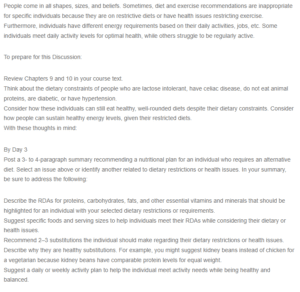Alternative Dietary Considerations
Patients with diabetes mellitus (DM) should adopt various nutritional plans to achieve better control of their condition. To accomplish this, The American Diabetes Association developed a recommended dietary allowance (RDA) for these patients. The RDA for proteins for these patients is 0.8 grams per kilogram daily (Beaudry & Devries, 2019). This accounts for about 10 to 35 percent of daily energy intake (Beaudry & Devries, 2019). The RDA for carbohydrates is 130 grams per day, whereas the RDA for fiber is 14 grams per 1000 kcal (DiabetesJournals.org, 2022). The RDA for cholesterol should be below 200 milligrams per day, whereas the RDA for saturated fats is 15 grams daily (DiabetesJournals.org, 2022).
People with DM should ensure that their serving sizes fulfill their RDA. They should consume three to five servings of vegetables daily (Singh, 2022). Examples include broccoli, spinach, and lettuce (Singh, 2022). In addition, grains and starches should account for six to eleven servings daily (Singh, 2022). Examples include cereal and rice. Fruits account for two to four servings daily (Singh, 2022). Examples include apricots and bananas. Meat and its substitutes account for four to six ounces daily (Singh, 2022). Examples of substitutes are eggs and cheese. Low-fat milk accounts for two to three servings daily.
Food substitutions will enable people with diabetes to better control their glycemic levels. They should substitute refined grains with whole grains. Notably, whole grains are low glycemic and avoid fluctuations in sugar levels (Gray & Threlkeld, 2019). Secondly, they should substitute red meat with seafood and white meat. Seafood and white meat are advantageous because they have lower calories and fats (Gray & Threlkeld, 2019).
The daily plan for diabetic patients should entail dietary modifications and physical activity. Dietary modification is based on RDAs. They should have four ounces of white meat or seafood spread across meals daily. Furthermore, their diet should entail four servings of fresh vegetables, two servings of fruits, and three servings of whole grains. Aerobic and resistance exercises should be done on alternate days.
References
Beaudry, K. M., & Devries, M. C. (2019). Nutritional Strategies to Combat Type 2 Diabetes in Aging Adults: The Importance of Protein. Frontiers in Nutrition, 6(August), 1–10. https://doi.org/10.3389/fnut.2019.00138
DiabetesJournals.org. (2022). Standards of Medical Care in Diabetes—2022 Abridged for Primary Care Providers. https://diabetesjournals.org/clinical/article/40/1/10/139035/Standards-of-Medical-Care-in-Diabetes-2022
Gray, A., & Threlkeld, J. R. (2019). Nutritional Recommendations for Individuals with Diabetes. https://www.ncbi.nlm.nih.gov/books/NBK279012/
Singh, A. (2022). Diabetes Food Pyramid. https://www.diabetes.co.uk/food/diabetes-food-pyramid.html
ORDER A PLAGIARISM-FREE PAPER HERE
We’ll write everything from scratch
Question
People come in all shapes, sizes, and beliefs. Sometimes, diet and exercise recommendations are inappropriate for specific individuals because they are on restrictive diets or have health issues restricting exercise. Furthermore, individuals have different energy requirements based on their daily activities, jobs, etc. Some individuals meet daily activity levels for optimal health, while others struggle to be regularly active.

Alternative Dietary Considerations
To prepare for this Discussion:
Review Chapters 9 and 10 in your course text.
Think about the dietary constraints of people who are lactose intolerant, have celiac disease, do not eat animal proteins, are diabetic, or have hypertension.
Consider how these individuals can still eat healthy, well-rounded diets despite their dietary constraints. Consider how people can sustain healthy energy levels, given their restricted diets.
With these thoughts in mind:
By Day 3
Post a 3- to 4-paragraph summary recommending a nutritional plan for an individual who requires an alternative diet. Select an issue above or identify another related to dietary restrictions or health issues. In your summary, be sure to address the following:
Describe the RDAs for proteins, carbohydrates, fats, and other essential vitamins and minerals that should be highlighted for an individual with your selected dietary restrictions or requirements.
Suggest specific foods and serving sizes to help individuals meet their RDAs while considering their dietary or health issues.
Recommend 2–3 substitutions the individual should make regarding their dietary restrictions or health issues. Describe why they are healthy substitutions. For example, you might suggest kidney beans instead of chicken for a vegetarian because kidney beans have comparable protein levels for equal weight.
Suggest a daily or weekly activity plan to help the individual meet activity needs while being healthy and balanced.

